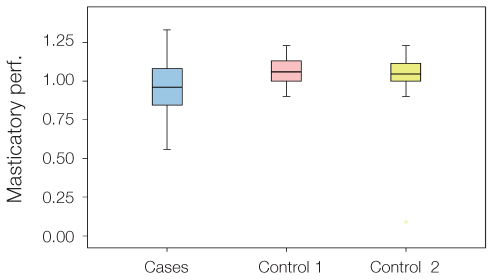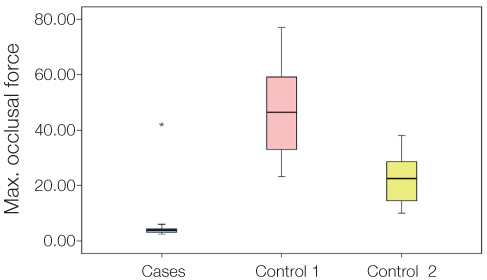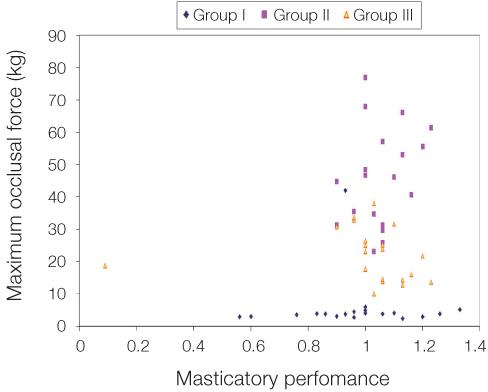J Adv Prosthodont.
2015 Feb;7(1):8-14. 10.4047/jap.2015.7.1.8.
Assessment of swallowing and masticatory performance in obturator wearers: a clinical study
- Affiliations
-
- 1Department of Prosthodontics, Faculty of Dental Science, King Georges Medical University, Lucknow, India. balendra02@yahoo.com
- 2Department of Surgical Oncology, King Georges Medical University, Lucknow, India.
- KMID: 1974884
- DOI: http://doi.org/10.4047/jap.2015.7.1.8
Abstract
- PURPOSE
To assess function by identifying changes in swallowing and masticatory performance in maxillary obturator prosthesis wearers.
MATERIALS AND METHODS
Sixty subjects were recruited for the study, of which 20 were obturator wearers, 20 were completely dentulous and 20 had removable partial/complete dentures with similar Eichner's Index. Swallowing ability was evaluated with and without obturator using the "Water Drinking Test"; Masticatory performance was evaluated with the Sieve test; and maximum occlusal force was recorded with the help of a digital bite sensor. The data was analyzed using the Statistical Package for Social Science version 15.0 with a confidence level at 95%.
RESULTS
Profile, behavior of drinking and time taken to drink were significantly improved (P<.001) in subjects after wearing obturator. Masticatory performance was not significantly different (P=.252) in obturator wearer when compared with dentulous or removable partial/complete denture wearer, but significantly (P<.001) high inter group difference in maximum occlusal force existed. Correlation between masticatory performance and maximum occlusal force was not significant (P=.124).
CONCLUSION
Swallowing ability was significantly improved after wearing obturator but masticatory performance was not significantly different from those having similar occlusal support zone in their dentition.
MeSH Terms
Figure
Reference
-
1. Minsley GE, Warren DW, Hinton V. Physiologic responses to maxillary resection and subsequent obturation. J Prosthet Dent. 1987; 57:338–344.2. Okay DJ, Genden E, Buchbinder D, Urken M. Prosthodontic guidelines for surgical reconstruction of the maxilla: a classification system of defects. J Prosthet Dent. 2001; 86:352–363.3. Bidra AS, Jacob RF, Taylor TD. Classification of maxillectomy defects: a systematic review and criteria necessary for a universal description. J Prosthet Dent. 2012; 107:261–270.4. Arigbede AO, Dosumu OO, Shaba OP, Esan TA. Evaluation of speech in patients with partial surgically acquired defects: pre and post prosthetic obturation. J Contemp Dent Pract. 2006; 7:89–96.5. Depprich R, Naujoks C, Lind D, Ommerborn M, Meyer U, Kübler NR, Handschel J. Evaluation of the quality of life of patients with maxillofacial defects after prosthodontic therapy with obturator prostheses. Int J Oral Maxillofac Surg. 2011; 40:71–79.6. Devlin H, Barker GR. Prosthetic rehabilitation of the edentulous patient requiring a partial maxillectomy. J Prosthet Dent. 1992; 67:223–227.7. Matsuyama M, Tsukiyama Y, Koyano K. Objective clinical assessment of change in swallowing ability of maxillectomy patients when wearing obturator prostheses. Int J Prosthodont. 2005; 18:475–479.8. Tang JA, Rieger JM, Wolfaardt JF. A review of functional outcomes related to prosthetic treatment after maxillary and mandibular reconstruction in patients with head and neck cancer. Int J Prosthodont. 2008; 21:337–354.9. Vega C, León X, Cervelli D, Pons G, López S, Fernández M, Quer M, Masià J. Total or subtotal glossectomy with microsurgical reconstruction: functional and oncological results. Microsurgery. 2011; 31:517–523.10. Speksnijder CM, van der Glas HW, van der Bilt A, van Es RJ, van der Rijt E, Koole R. Oral function after oncological intervention in the oral cavity: a retrospective study. J Oral Maxillofac Surg. 2010; 68:1231–1237.11. Kreeft AM, Krap M, Wismeijer D, Speksnijder CM, Smeele LE, Bosch SD, Muijen MS, Balm AJ. Oral function after maxillectomy and reconstruction with an obturator. Int J Oral Maxillofac Surg. 2012; 41:1387–1392.12. Ikebe K, Matsuda K, Murai S, Maeda Y, Nokubi T. Validation of the Eichner index in relation to occlusal force and masticatory performance. Int J Prosthodont. 2010; 23:521–524.13. Aramany MA. Basic principles of obturator design for partially edentulous patients. Part I: Classification. 1978 [classical article]. J Prosthet Dent. 2001; 86:559–561.14. Beumer John III, Marunick Mark T, Garret Neal, Rohner Dennis, Reintsema Harry, Abemayor Elliot, Penn Renee, Nabili Vishad, Bucher Peter. Rehabilitation of maxillary defects. In : Beumer John, Marunick Mark T, Esposito Salvatore J, editors. Maxillofacial rehabilitation. Illinosis: Quintessence publishing Co, Inc;2011. p. 168–170.15. Ahila SC, Anitha KV, Thulasingam C. Comparison of obturator design for acquired maxillary defect in completely edentulous patients. Indian J Dent Res. 2011; 22:161–163.16. Badadare MM, Patil SB, Bhat S, Tambe A. Comparison of obturator prosthesis fabricated using different techniques and its effect on the management of a hemipalatomaxillectomy patient. BMJ Case Rep. 2014; 2014:pii: bcr2014204088.17. Omo J, Sede M, Enabulele J. Prosthetic rehabilitation of patients with maxillary defects in a nigerian tertiary hospital. Ann Med Health Sci Res. 2014; 4:630–633.18. Kumar P, Jain V, Thakar A, Aggarwal V. Effect of varying bulb height on articulation and nasalance in maxillectomy patients with hollow bulb obturator. J Prosthodont Res. 2013; 57:200–205.19. Matsuyama M, Tsukiyama Y, Tomioka M, Koyano K. Clinical assessment of chewing function of obturator prosthesis wearers by objective measurement of masticatory performance and maximum occlusal force. Int J Prosthodont. 2006; 19:253–257.20. Wedel A, Yontchev E, Carlsson GE, Ow R. Masticatory function in patients with congenital and acquired maxillofacial defects. J Prosthet Dent. 1994; 72:303–308.21. Rottner K, Richter EJ. Effect of occlusal morphology on the accuracy of bite force measurements using thin film transducers. Int J Prosthodont. 2004; 17:518–523.22. Sun J, Jiao T, Tie Y, Wang DM. Three-dimensional finite element analysis of the application of attachment for obturator framework in unilateral maxillary defect. J Oral Rehabil. 2008; 35:695–699.23. Parr GR, Tharp GE, Rahn AO. Prosthodontic principles in the framework design of maxillary obturator prostheses. 1989. J Prosthet Dent. 2005; 93:405–411.24. King GE, Gay WD. Application of various removable partial denture design concepts to a maxillary obturator prosthesis. J Prosthet Dent. 1979; 41:316–318.25. Irish J, Sandhu N, Simpson C, Wood R, Gilbert R, Gullane P, Brown D, Goldstein D, Devins G, Barker E. Quality of life in patients with maxillectomy prostheses. Head Neck. 2009; 31:813–821.26. Moreno MA, Skoracki RJ, Hanna EY, Hanasono MM. Microvascular free flap reconstruction versus palatal obturation for maxillectomy defects. Head Neck. 2010; 32:860–868.27. Riaz N, Warriach RA. Quality of life in patients with obturator prostheses. J Ayub Med Coll Abbottabad. 2010; 22:121–125.28. Strek P, Oleś K, Składzień J, Tomik J, Gajec S, Kocoń S, Dutsch-Wicherek M, Hartwich P, Szaleniec J. Quality of life in patients treated for cancer of paranasal sinus and other area at head and neck. Przegl Lek. 2010; 67:1298–1301.29. Shiga H, Kobayashi Y, Arakawa I, Shonai Y. Selection of food and chewing side for evaluating masticatory path stability. Odontology. 2003; 91:26–30.30. Matsuyama M, Tsukiyama Y, Tomioka M, Koyano K. Subjective assessment of chewing function of obturator prosthesis wearers. Int J Prosthodont. 2007; 20:46–50.31. Ohara A, Tsukiyama Y, Ogawa T, Koyano K. A simplified sieve method for determining masticatory performance using hydrocolloid material. J Oral Rehabil. 2003; 30:927–935.32. Tamut T, Pooran C, Pratap SB, Arvind T, Jitendra R, Dayal SR. Effect of bone mineral density on masticatory performance and efficiency. Gerodontology. 2012; 29:e83–e87.33. Jain V, Mathur VP, Pillai RS, Kalra S. A preliminary study to find out maximum occlusal bite force in Indian individuals. Indian J Dent Res. 2014; 25:325–330.34. Koç D, Doğan A, Bek B. Effect of gender, facial dimensions, body mass index and type of functional occlusion on bite force. J Appl Oral Sci. 2011; 19:274–279.35. Proffit WR, Fields HW. Occlusal forces in normal- and long-face children. J Dent Res. 1983; 62:571–574.36. MacDonald JW, Hannam AG. Relationship between occlusal contacts and jaw-closing muscle activity during tooth clenching: Part I. J Prosthet Dent. 1984; 52:718–728.37. Kikuchi M, Korioth TW, Hannam AG. The association among occlusal contacts, clenching effort, and bite force distribution in man. J Dent Res. 1997; 76:1316–1325.38. Rovira-Lastra B, Flores-Orozco EI, Salsench J, Peraire M, Martinez-Gomis J. Is the side with the best masticatory performance selected for chewing? Arch Oral Biol. 2014; 59:1316–1320.
- Full Text Links
- Actions
-
Cited
- CITED
-
- Close
- Share
- Similar articles
-
- A STUDY ON MASTICATORY PERFORMANCE AND MUSCLE ACTIVITY IN REMOVABLE PARTIAL DENTURE WEARERS
- Fabrication of implant-associated obturator after extraction of abutment teeth: a case report
- Implant assisted obturator in patient after maxillectomy: a case report
- Prosthetic rehabilitation of partially edentulous patient after maxillectomy: A case report
- Clinical Evaluation of the Swallowing




